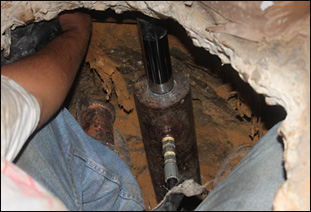What Is “Mudjacking” and Why You May Need It

“Mudjacking” is a process used as part of some foundation repairs. There are 2 types of mudjacking. The first type is the hydraulic mudjacking. Hydraulic mudjacking entails drilling small holes in a concrete slab and pumping a cement slurry under high pressure. The slurry is injected between the supporting ground and the slab. If sufficient pressure is applied, the slab can be lifted. Controlling the high-pressure slurry and what is actually lifted can be a challenge. Additionally, the high pressure can do damage to below slab pipes, especially when the pipes are old cast iron. Therefore, it is typically efficient to lift a concrete slab with piers or pilings.
The second type of mudjacking is used to fill the void created when a concrete slab is lifted off the supporting ground with piers or pilings. If a concrete slab is lifted sufficiently with piers or pilings, a void is sometimes created between the slab and the underlying soil. In this scenario, the slab is lifted and supported by the piers or pilings. However, there may not be sufficient rigidity of the slab to support the part of the slab adjacent to where the piers or pilings are installed. If that is the case, the part of the slab that is adjacent to the part supported by piers or pilings may “sag” under its own weight. If this is a possibility, low pressure or void filling mudjacking can be performed. In this process, a cement slurry is pumped under low pressure to fill the void that was created by the lift. After curing, the “mud” essentially puts the slab back in contact with the ground adding support.
Structured Foundation Repairs installs concrete and steel pilings and recommends low-pressure mudjacking to fill voids when needed. Call today for a free, comprehensive evaluation of your foundation and the drainage around your home.
